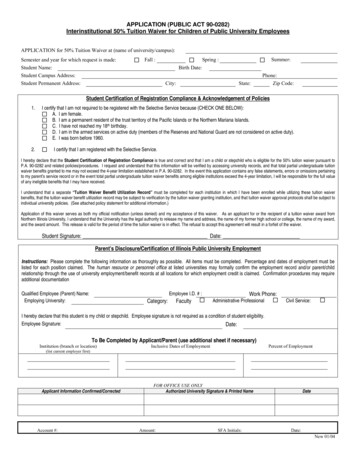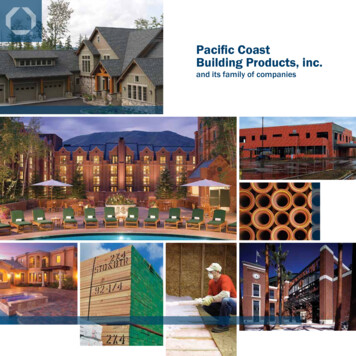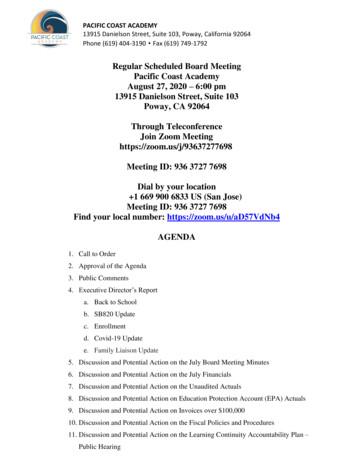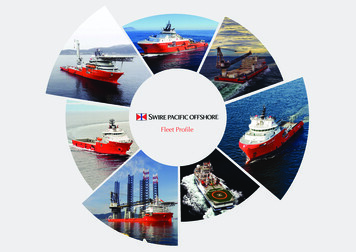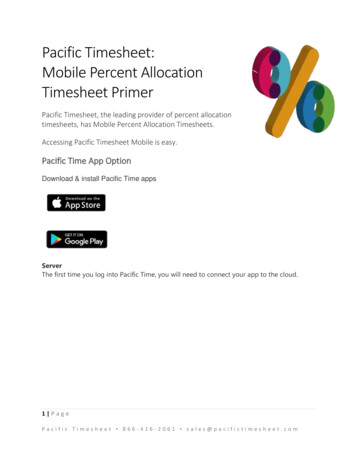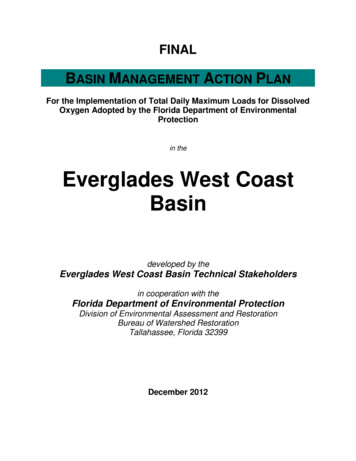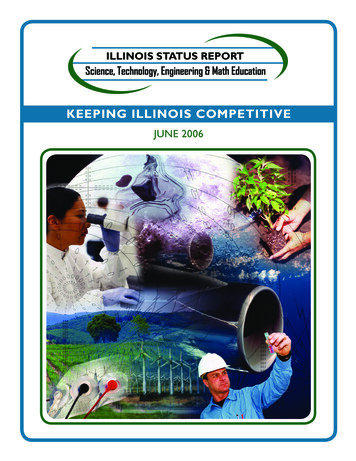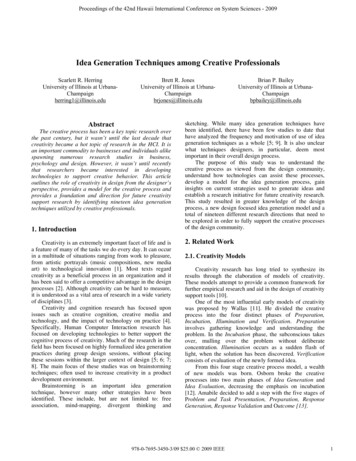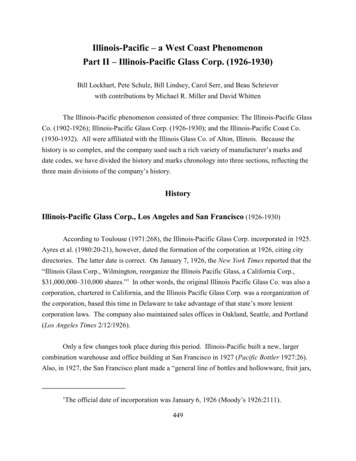
Transcription
Illinois-Pacific – a West Coast PhenomenonPart II – Illinois-Pacific Glass Corp. (1926-1930)Bill Lockhart, Pete Schulz, Bill Lindsey, Carol Serr, and Beau Schrieverwith contributions by Michael R. Miller and David WhittenThe Illinois-Pacific phenomenon consisted of three companies: The Illinois-Pacific GlassCo. (1902-1926); Illinois-Pacific Glass Corp. (1926-1930); and the Illinois-Pacific Coast Co.(1930-1932). All were affiliated with the Illinois Glass Co. of Alton, Illinois. Because thehistory is so complex, and the company used such a rich variety of manufacturer’s marks anddate codes, we have divided the history and marks chronology into three sections, reflecting thethree main divisions of the company’s history.HistoryIllinois-Pacific Glass Corp., Los Angeles and San Francisco (1926-1930)According to Toulouse (1971:268), the Illinois-Pacific Glass Corp. incorporated in 1925.Ayres et al. (1980:20-21), however, dated the formation of the corporation at 1926, citing citydirectories. The latter date is correct. On January 7, 1926, the New York Times reported that the“Illinois Glass Corp., Wilmington, reorganize the Illinois Pacific Glass, a California Corp., 31,000,000–310,000 shares.”1 In other words, the original Illinois Pacific Glass Co. was also acorporation, chartered in California, and the Illinois Pacific Glass Corp. was a reorganization ofthe corporation, based this time in Delaware to take advantage of that state’s more lenientcorporation laws. The company also maintained sales offices in Oakland, Seattle, and Portland(Los Angeles Times 2/12/1926).Only a few changes took place during this period. Illinois-Pacific built a new, largercombination warehouse and office building at San Francisco in 1927 (Pacific Bottler 1927:26).Also, in 1927, the San Francisco plant made a “general line of bottles and hollowware, fruit jars,1The official date of incorporation was January 6, 1926 (Moody’s 1926:2111).449
milk bottles and jelly glasses [along with] ‘Electroneal’ ware’” at three continuous tanks with 12feeders (American Glass Review 1927:137).In June 1928, the company broke ground for the new 750,000 plant at Los Angeles. Theplant began operation on February 15, 1929 (Moody 1929:149; Wall Street Journal 6/6/1928).The factory, Plant No. 2 in Los Angeles, was intended to supply Southern California, Arizona,New Mexico, Nevada, and Utah, as well as “the Orient, Antipodes and South and CentralAmerican countries which have previously been served from San Francisco (Los Angeles Times6/10/1928). The new plant had a single continuous tank and five feeders (American GlassReview 1929:99). By at least 1930 (probably earlier), hand operations had completely ceased,and all plants only produced bottles by machine (Shippey 1930:A4). Illinois-Pacific mergedwith the Pacific Coast Glass Co. to form the Illinois-Pacific Coast Co. in 1930.Containers and MarksFor background information on the bottles and marks of the entire Illinois-Pacific GlassCo., see the preceding section.IPG in a Triangle (1925-1931)As far as we can discover (except for the PRESTO jars),the only mark ever used by the corporation was IPG in a triangle(despite the claim by Toulouse that three variations were used).This mark was mostly embossed on heels of the bottles (as notedon soft drink, food, and milk bottles), although it was occasionallyplaced on bases of medicine, some beer, occasional soda, somefood bottles, and possibly othertypes (Figures 1 & 2). Thelogo uniformly maintained theFigure 1 – Triangle-IPGbasemarksame shape and was oftenaccompanied by numbers that fit into identifiable patterns.Figure 2 – Triangle-IPGheelmarkThe “I” leaned in toward the center as did the “P” with the“G” slanted backwards. The apex of the triangle had a tiny,450
solid, embossed triangle above the “P.” Each IPG mark we have examined followed thispattern, although Robert Leavitt (personal communication, 5/11/2005) reported a single examplethat lacked the smaller, solid triangle at the apex. This was probably an engraver’s error, quitecommon during the 1920s and for two decades to follow.Jones (1965:[16]) was the first researcher to report this mark. According to her, T.L.Keusseff claimed that “this was the mark of Illinois Pacific in the 1920’s, prior to the mergerwith Pacific Coast . . . . Trade mark after 1924 ‘Electroneal.’” Three years later (1966:20),Jones again mentioned the triangle mark but with a completely incorrect date of 1903. Toulouse(1971:268-269) also included this mark, again with no specific information. Giarde (1980:55)discussed the mark as used on milk bottles. He claimed that single-digit date codes were foundto the left of the triangle “particularly in the late 1920’s” and noted that “the triangle mark is theone found on milk bottles.”Most of the bottles we studied were soft drink bottles used in Arizona along with somefrom New Mexico and El Paso, Texas. However, all bottles (including milks and households)we have found with the Triangle IPG mark could be dated from 1925 to 1931. We attribute themark to the “Corporation” period, although the mark was used by at least January 1925 – duringthe “Company” period.ElectonealAdvertisements for Illinois Pacific from at least May1926 to March 20, 1930, showed the Triangle-IPG mark withthe tiny triangle at the apex (Figure 3). The mark accompaniedads for milk, soft drink, and food bottles. In addition, the adstouted electrically annealed bottles and claimed that the processcould almost double the use life of bottles. The earliest milkbottle ad (Western Milk Dealer May 1926) we have found notedthat “the ordinary milk bottle lives 17 round trips – some moreand some less – but seventeen trips on average.” However, itclaimed that “electronically annealed milk bottles livepractically twice as long.” By September, the company had451Figure 3 – Ad with trianglelogo (Pacific Bottler Feb.1928)
named the process Electroneal (Figure 4). An ad that month inthe Western Milk Dealer claimed that “Electroneal Milk Bottlesnever spall–they are perfectly tempered, tough, and durable.They resist the action of pasteurizing indefinitely. They telltheir own age by the date on the top of the finish” (see thediscussion of this rim-code dating process in Part I of this seriesand below). The company also created a paperweight tocelebrate the process (Figure 5).Charles C. Cole (1926:40), President of Illinois-PacificGlass Corp., followed the ads with an article that described theprocess as thermostatically controlling the annealing so that theideal temperatures weremaintained and changed toFigure 4 – Electroneal ad(Western Milk Dealer May1926)create the strongest bottle. He claimed that no fuel sourcecould match the efficiency offered by electrically heating theannealing oven. He finished by noting: “The impossibility ofexpressing all of this thought in brief form has given rise to theneed for coining a new word and hence the addition to theFigure 5 – Illinois-Pacificpaperweightdictionary of the word ‘Electroneal.’”Fruit JarsCreswick (1987:31) reported the triangle mark on the base of a Boyd Mason jar. BoydMasons were made by the earlier Illinois Pacific Glass Co. but were probably discontinued withthe reorganization. The triangle mark was also positioned at the back of the heel as in the caseof the Getsbest jar (Creswick 1987:57; Roller 1983:137). The Improved Everlasting Jar (alsomade by the earlier “company”) was also embossed with the triangle logo on the heel (Roller1987:165). See the first part of this series for more information on Boyd Masons and ImprovedEverlasting jars.452
Milk BottlesIllinois Pacific adopted a somewhat unique system forembossing date codes on bottles. Although the system wasapparently developed by the Southern Glass Co. (Vernon,California), it was soon practiced by several glass houses in thestate – but is unknown in any other area we have found. IllinoisPacific’s May 1926 ad (Western Milk Dealer) noted that milkbottles “are dated on the top of the finish so you can figure foryourself” (Figure 6). The one-or two-digit number on the leftFigure 6 – Rim Code(California State Parks)side (1-12) of the rim is a code for the month the bottle wasmade, and the single-digit numeral on the right side is a year code. The year codes for IllinoisPacific extend from 5 to 0, indicating 1925 to 1930 (although some bottles with Triangle-IPGlogos extend to “3” (1933).Milk bottles with the triangle mark generally had a single-digit number, usually to theleft of the mark, although it was occasionally to the right or even below. Double-digit numberswere almost always to the left (one case below). Numbers in our sample ranged from 1 to 29and included virtually every number in between. Occasionally, a mark had a two-digit numberto the left and a single-digit number to the right. These numbers did not match either month oryear rim codes, nor did they correspond with bottle sizes (e.g., number “1” is found in half-pint,pint, and quart sizes). Since two-digit codes contained numbers “10,” “11,” “12.” etc., they werefar too early to have been date codes. All evidence we have found shows that the Triangle-IPGmark showed up ca. 1925 (see Figure 2 & Figure 35 in Part I).The Triangle-IPG mark was much more likely to occur on the heel than the base. Of 109examples of the mark that we observed in the California Parks collection, only two were placedon the base (1.8% of the sample – 98.2% occur on the heel).Soda BottlesBeginning in 1927, soft drink bottles with the triangle mark displayed two notablepatterns: 1) {number} – {number} located somewhere away from the mark (e.g., 7 - 1); or 2)453
{number} Triangle-IPG {number} (e.g., 8 Triangle-IPG 5). The manufacturer’s marks werealmost always embossed on the heels; we have found only one number pattern that appeared ona base. We found the first pattern inconsistently placed on the front or on the back heel,regardless of the location of the manufacturer’s mark.On bottles that should be from 1926, there were no identifiable datecodes accompanying the Triangle-IPG marks. However, the number “7”appeared in one of the formats described above (usually the number to theleft) on all bottles that we have been able to date to ca. 1927 (Figure 7).2This is the first year for the use of a date code on soda bottles by IllinoisPacific. Interestingly, we came to this conclusion based on empiricalevidence, then discovered that a June 1927 ad was the earliest we can findthat discussed date codes on soft drink bottles (Pacific Bottler). The addstated: “Our ELECTRONEAL bottle will carry more beverage from yourplant to the consumer than any other bottle because it is durable and longlived. To enable you to prove this to your own satisfaction, the date ofmanufacture is placed on every bottle.”Porter (2009) reported a slightly different pattern in hobble-skirtCoca-Cola bottles. Illinois-Pacific apparently first made Coke bottles inthe “PAT’D NOV 16, 1915” variation in 1926, and these had the IllinoisPacific triangle on the heel. Single- or double-digit numbers, usually on theopposite side of the bottle from the logo, appear to have been moldFigure 7 – Heel &finish codes(Miller 2008:52)number. In 1927, however, the heelmarks began to follow the first pattern described above.Unlike most of the other (non-hobble-skirt) bottles, these also had a small “7” embossed on thereinforcing ring of the crown finish.2Both Miller, in Arizona (e.g., Miller 1999; 2008), and Lockhart, in El Paso, Texas, andSouthern New Mexico (e.g., Lockhart 2000) have extensively dated local bottles using acombination of company information, manufacturer’s marks, possible code combinations,manufacturing techniques, and the observation of hundreds, possibly thousands, of bottles. Thisresulted in many cases in the development of a chronology for bottles initially used by acompany within a one- or two-year period. These techniques have enabled us to develop, test,and often confirm possible date codes on many bottles.454
Another interesting ramification has surfaced. Because of the information on milk bottlerim codes, we reappraised our ideas about soda bottle marks. With a single exception, in everyexample of the mark we have examined, there are two codes (from 1927 on). Initially, wethought that one of these was a date (year) code, and the other was a mold number. However, ina total of almost 50 marks, every number (usually on the left of the code sequence) was between1 and 12. Since milk bottles during this period were embossed with both the month and the yearof manufacture, it is almost certain that the second codes on soda bottles are codes for the monthof manufacture. Note that month codes do not appear on Coca-Cola bottles. Porter showedcodes of 7-13, 7-60, 9-13, 9-14, and 9-15 on Coke bottle bases, demonstrating that the second setof digits were not month codes.In 1928, the numeral “8” was usually a part of the code and generally appeared also onthe crown finish. The numeral was embossed on the reinforcing ring (the second or lower, morebulbous area of the crown). We have found a single amber soda/near-beer bottle with a “7”embossed on the reinforcing ring and a 7 {triangle mark} 3 on the heel (see Figure 7). Thisindicates that the crown date codes were used at least as early as 1927, although the crownlocation was much more common in 1928. See Miller (2008) for numerous examples of allthese date codes.Occasionally, the numeral “7” was in the codes associated with the mark, but “8” was onthe crown. In all likelihood, this represented a transition to date codes embossed on the crown.Bottles with “7” near the manufacturer’s mark were probably made from molds cut in 1927.When the engraver added the “8” at the crown, he likely forgot to change the heel number.Examples of this kind of error during a transformation period are common on Owens-IllinoisGlass Co. bottles as well, and careful examination often reveals where an old code wasobliterated and a new digit added to update the year. The date code on the crown probablybegan sometime during the year, so bottles exist in both configurations.Coca-Cola bottles again formed an interesting pattern. During 1928, Illinois-Pacificchanged from the “PAT’D NOV 16, 1915” Coke bottle to the “PAT’D DEC 25, 1923” style. Allof the 1915 hobble-skirt bottles recorded by Porter (2009) only had the “8” date code at the heel.The 1923 variation bottles, however, uniformly had the second pattern of the logo/codes (i.e.,{number} Triangle-IPG {number}) on the heel and the “8” code on the reinforcing ring. A455
single 1915 bottle was made in 1929 for the San Francisco Coca-ColaBottling Co., but this is almost certainly a reuse of an old set of sidemolds and a new baseplate. The format of the heelmarks followed thesecond pattern.The move to the crown seems to have been completed by 1929,although occasional examples still retained an “8” near themanufacturer’s mark (Figure 8). As above, this was a common errorduring transitions. Most Coke bottles followed the move to thereinforcing ring only, but a few retained the heel codes in the secondpattern (Porter 2009).In 1930, the only consistentlyidentifiable date code was embossed on thecrown, although two examples attributed to thatyear did not have marks on the crown (Figure9). One of these exceptions, however, had a“0” next to the manufacturer’s mark (probablyFigure 8 – Heel &finish codes (Miller2008:45)indicating 1930). All of the hobble-skirt CocaCola bottles recorded by Porter (2009) had the “30” on the reinforcingring, but, in most cases, the “30” was embossed over a “9.” Almost allalso had “9 Triangle-IPG {number} embossed at the heel. Several ofthese had a “0” embossed on top of the “9.” This provides solidevidence that virtually all of the Coke bottles made in 1930 were madefrom the older 1929 molds.Even though the merger that created the Illinois Pacific CoastFigure 9 – Heel &finish codes (Miller2008:26)Co. was made in 1930, some bottles with date codes for 1931 stillretain an identifiable IPG mark (instead of the expected IPC mark).This probably indicates the use of a mold until it wore out or the fillingof existing contacts after the change in name (or both). However, the“31” date codes may be found either on the crown or in conjunction with the manufacturer’smark at the heel. This practice is documented by Smith (1989:25-27) in describing the Ball456
Brothers takeover of the Three Rivers Glass Co. Again following the pattern,this inconsistency of mark placement was also documented by Porter (2009)on Coke bottles. Some 1931 marks are only on the heel; others are on bothheel and crown. By 1930, codes on both sides of the mark were oftenunrelated to the date or month (Figure 10).MANUFACTURED BY ILLINOIS PACIFIC GLASS CORP.and PRESTO JARS (1927-1930)Toulouse (1969:247-248)discussed the Presto jar series,noting that the jars were made byboth the Illinois Glass Co. andIllinois-Pacific – although he didnot include the variations inIllinois-Pacific heelmarks. Roller(1987:293) also featured thePRESTO GLASS TOP with theFigure 10 – Heel& finish codes(Miller2008:182)mark but not the Mason jars.Figure 11 – Presto Supreme (Creswick1987:106-107)The Illinois Glass Co.and its subsidiaries(including Illinois-Pacific)made the “PRESTO” series of jars after March 1, 1927 (the date of firstuse on the trademark document). The Illinois Glass Co. registered the“PRESTO” logo (#243,989) on July 3, 1928 (Creswick 1987:155).Both “PRESTO GLASS TOP” jars and “PRESTO SUPREMEMASON” jar were embossed “MANUFACTURED BY ILLINOISPACIFIC GLASS CORP.” in two lines across the back heels of the jarsFigure 12 – PrestoSupreme (eBay)(Creswick 1987:106-107 – Figures 11-13).Contrary to Creswick’s statement (1987:106), the jars were not made by the earlierIllinois Pacific Glass Co. The “Co.” ended in 1926, a year before the PRESTO logo was ever457
used. The Roller update (2011:432-433) also questionedher identification of the “Corp.” logo on the PrestoSupreme Mason. The Roller editors only noted the“Corp.” embossing on the Presto Glass Top jars. See alsothe last entry in Part I of this series and “PRESTO” jars inPart III. These jars were probably made for export –hence the embossing of the full name (see discussion inPart I).Figure 13 – Presto heelmark (eBay)Discussion and ConclusionsAside from a few jars embossed with the entire Illinois-Pacific name, the “corporation”only seems to have used a single mark, IPG in a triangle. Even though the mark was originallyused during the “company” period, beginning in January 1925, its greatest use was between 1926and 1931 – extending into the Illinois-Pacific Coast Co. period (see Part III). Of greaterimportance, from a dating perspective, the corporation embossed codes showing both the monthand year of manufacture on milk bottles as early as 1925 and soda bottles by 1927. These aresome of the most finely dated glass containers ever made.It is tempting to seek parallels between Illinois-Pacific and the Illinois Glass Co., but thetwo firms had separate developments. The logos were dissimilar, and the Illinois Glass Co.never developed a date code system – while Illinois-Pacific used extensive date codes. Rimcodes on milk bottles were an exclusive West Coast phenomenon that was never copied ordeveloped in other parts of the country. In addition, Illinois-Pacific did not share its Electornealsystem with the eastern firm. Oddly, since other areas remained separate, both firms madePresto jars.AcknowledgmentsOur gratitude to Doug Leybourne for letting us reproduce the drawings from the AliceCreswick books and to Wanda Wakkinen for doing our proofreading.458
SourcesAmerican Glass Review1927 “Glass Factory Yearbook and Directory.” American Glass Review, Pittsburgh,Pennsylvania.1929 “Glass Factory Yearbook and Directory.” American Glass Review, Pittsburgh,Pennsylvania.Ayres, James E., William Liesenbien, Lee Fratt, and Linda Eure1980 “Beer Bottles from the Tucson Urban Renewal Project, Tucson, AZ.” Unpublishedmanuscript, Arizona State Museum Archives, RG5, Sg3, Series 2, Subseries 1, Folder220.Cole, Charles C.1926 “Glass Process Developed.” Western Canner and Packer 8(7):40).Creswick, Alice1987 The Fruit Jar Works, Volume II, Listing Jars Made Circa 1900 to Modern.Privately printed, Grand Rapids, Michigan.Giarde, Jeffery L.1980 Glass Milk Bottles: Their Makers and Marks. Time Travelers Press, Bryn Mawr,California.Jones, May1965 The Bottle Trail, Volume 5. Nara Vista, New Mexico.1966 The Bottle Trail, Volume 6. Nara Vista, New Mexico.Los Angeles Times1926 “New Industry Acquired.” Los Angeles Times 1926, February 12, 1926.459
1928 “Plant to Boost Pay Rolls.” Los Angeles Times June 10.Lockhart, Bill2000 Bottles on the Border: The History and Bottles of the Soft Drink Industry in ElPaso, Texas, 1881-2000. Townsend Library, New Mexico State University atAlamogordo. http://alamo.nmsu.edu/ lockhart/EPSodas/Miller, Michael R.1999 A Collector’s Guide to Arizona Bottles & Stoneware: A History of MerchantContainers in Arizona. Privately Printed, Peoria, Arizona.2008 A Collector’s Guide to Arizona Bottles & Stoneware: A History of MerchantContainers in Arizona. 2nd ed. Privately Printed, Peoria, Arizona. [Note: this is a majorrevision on his 1999 book with numerous additions.]Moody, John1926 Moody’s Manual of Investments and Security Rating Service. Moody’s InvestorsService, New York.1929 Moody’s Manual of Investments: American and Foreign. Moody’s InvestorsService, New York, New York.Pacific BottlerJune 1927-February 1930.Porter, Bill2009 Unpublished database of 1915 and 1923 Coca-Cola bottles. Printed copies inauthors’ possession.Roller, Dick1983 Standard Fruit Jar Reference. Privately published.460
2011 Standard Fruit Jar Reference: 2011 Update. Edited by Jerome McCann and BarryBernas. Fruit Jar Annual/Phoenix Press, Chicago.Shippey, Lee1930 “Lee Side o’ L.A.” Los Angeles Times September 13:A4.Smith, Michael David1989 Texas Glass: An Illustrated History of the Three Rivers Glass Company 19221937. Atwood Printing, New Braunfels, Texas.Toulouse, Julian Harrison1969 Fruit Jars. Thomas Nelson & Sons, Camden, New Jersey.1971 Bottle Makers and Their Marks. Thomas Nelson, New York.Wall Street Journal1928 “Illinois Pacific Glass Company.” Wall Street Journal June 6, 1928.Western Milk Dealer and Dairy Counselor. May 1926-April 1928.Last updated 8/11/2016461
462
corporation laws. The company also maintained sales offices in Oakland, Seattle, and Portland (Los Angeles Times 2/12/1926). Only a few changes took place during this period. Illinois-Pacific built a new, larger combination warehouse and office building at San Francisco in 1927 (Pacific Bottler 1927:26).
